Modern backyard chickens are managed much differently from grandma’s chickens. They are being spoiled with treats, getting fat and dying from obesity-related complications. In order to spare our feathered pets the deadly consequences of obesity, we must familiarize ourselves with its causes, acknowledge our role in contributing to it and take affirmative steps to quash it.
photo sourceHow do our chickens differ from Grandma’s chickens?
PURPOSE & LIFE EXPECTANCY
Grandma’s chickens were kept as livestock and their days, numbered. Their primary purpose was to feed the family both eggs and meat. They were not named or doted upon. They may have lived a year or two at most. After their prime egg-laying days had passed, they filled the freezer for the coming year’s meals. If they were sick or injured, they were Sunday dinner that week.
Today’s backyard chickens are kept for eggs and as pets. They are valued companion animals with the potential to qualify for discounts on their morning coffee at McDonald’s (that’d be Old McDonald’s, of course). A 2004 United States Department of Agriculture study bears witness to that fact, revealing that 69 percent of backyard chicken-keepers surveyed kept chickens for fun/as a hobby. We give them names and they are free to live out their natural lives in our yards without regard to their declining productivity. When they are sick or injured, we tend to them and try diligently to find them qualified medical care providers. It is not uncommon for a backyard pet chicken to live 8-10 years, some, longer. Alarmingly, it is also not uncommon for pet chickens to die from obesity prematurely.
EXERCISE
Grandma’s chickens spent the entire day walking around the pasture, hunting, scratching and pecking for breakfast, lunch and dinner. When startled by another farm animal or threatened by a predator, they had the space available to fly short distances to safety.
A considerable number of today’s backyard flocks are primarily confined to an enclosed chicken run for a variety of reasons, mainly due to the threat of predation. If they wore tiny pedometers, their daily totals would pale in comparison to Grandma’s chickens’. Grandma’s birds got a great deal more exercise every day than today’s chickens do.
Viagra tages til behandling af erektil dysfunktion apoteken24.com, som gør et medlem af det stærke køn ude af stand til at opnå eller opretholde en erektion i penis og som følge heraf at have et fuldt samleje. Det er vigtigt at forstå, at ovenstående lægemiddel kun virker, hvis der er seksuel stimulering.
DIET
For the most part, Grandma’s chickens fended for themselves. They free-ranged on pasture all day, returning to the coop at dusk, greeted perhaps with a few handfuls of cracked corn tossed in the yard. They enjoyed the freshest variety of vegetation, insects and small critters nature had to offer. They managed their own nutritional intake with few, if any, extras from the farmhouse kitchen.
Today’s backyard laying hens have the benefit of bagged chicken feed. Most have access to layer rations at all waking hours, which they should be, but most are “spoiled” with extras such as table scraps, fruits, vegetables, sprouts, dried mealworms, scratch, watermelon in the summer, warm oatmeal in the winter and pumpkin treats in the fall. We hang pecking treats for them to quell our fears that they may be bored and bake molt muffins for them in autumn. It is not uncommon for today’s pet chickens to be treated to dietary extras several times a day.
Grandma’s chickens ate a self-prescribed diet of whatever they could find, exercised more and consumed fewer treats, if any. As much as we dote on our chickens, seek to keep them healthy and care for their medical needs, we are contributing to the premature demise of many of our pets by making them fat. Obesity has deadly ramifications for chickens. Fortunately, with a little education and a few common sense modifications to their lifestyle, obesity can be prevented and controlled.
Since most backyard flocks consist almost exclusively of laying hens, this discussion focuses on them.
CAUSE OF OBESITY
It’s simple: if she eats improperly and does not exercise enough, she is going to gain fat weight. A fully grown hen should not continue to gain weight. If she does, she will first retain it in the form of excess fat in her abdomen and liver. As she continues to gain weight, fat will eventually be felt and seen between the tip of her keel bone and her vent. Unfortunately, by the time this abdominal fat pad is felt or seen underneath the skin, serious liver damage has already occurred.
This is an obscene amount of fat in the abdomen and on the breast of a hen I thought was a healthy weight. She did not die from obesity-related complications, but it was likely just a matter of time before she did.
THE DEADLY HAZARDS OF OBESITY:
HEAT STROKE & FATTY LIVER HEMORRHAGIC SYNDROME (FLHS)
Obesity can cause decreased fertility, frequent multiple-yolked eggs, oversized eggs, egg-binding and prolapsed vent. The two most common obesity-related causes of death in laying hens are heat stroke and Fatty Liver Hemorrhagic Syndrome, abbreviated FLHS. According to Dr. Mike Petrik, DVM, MSc, a laying hen veterinarian in Ontario Canada, “Obesity causes sudden death from ‘Fatty Liver Hemorrhagic Syndrome,’ where the liver fills with fat, becomes fragile, splits and causes the bird to bleed to death.” A minor impact to the chest or the abdominal pressure generated during egg-laying is sufficient to cause an obese hen’s fragile, fat-filled liver to shatter, resulting in death from internal bleeding.
HEAT STROKE
With excess fat in her abdomen, hot weather becomes life-threatening to a hen. Without sweat glands, she relies upon respiration to regulate her internal temperature. If abdominal fat is in the way, she cannot breathe properly, she cannot regulate her body temperature and she can die of heat stroke within a matter of minutes.
The following three minute video vividly illustrates the complex avian respiratory system and provides an amazing visual demonstration of why abdominal fat is life-threatening to a hen in hot weather.
The keys to fighting obesity in backyard chickens is found in a familiar formula: a nutritionally balanced diet plus plenty of exercise.
4 STEPS TO PREVENT OBESITY IN LAYING HENS:
1. MONITOR THEIR WEIGHT
This may sound completely ridiculous and/or too arduous a task to those with more than a few backyard chickens, but if you know that you are the type of person inclined to lavish treats/snacks/leftovers on your chickens, weighing them is the only way to know whether those treats are negatively impacting their health. This is the scale I use.
Fully grown hens should maintain a consistent weight. Changes in weight in a mature hen are a sign of a problem. Weigh hens regularly. If they are losing weight, there is a problem that must be ferreted out (illness, worms, etc) and if they are gaining weight, they are being over-fed.
There are two excellent charts that list the standard weights for mature chickens by breed here and here.
2. FEED A BALANCED DIET.
Dr. Petrik states that “feeding a well-balanced ration helps the hens metabolize fat more efficiently.” Feed a commercially prepared feed, which has been very carefully formulated by poultry nutritionists who meticulously monitor the composition and safety of ingredients to ensure that a hen’s daily nutritional requirements are met. I strongly recommend against dabbling in assembling homemade feeds. Imprecise calculations, the wrong ingredients, missing ingredients, excess ingredients and ingredients that are improperly prepared or stored can all result in behavioral and health problems, not the least of which is obesity. Nutritionally complete rations are not found in recipes downloaded from the Internet. Poultry nutrition is a complicated science and there is much more to it than simply combining pantry ingredients.
A free-feed dining option is the most common in backyard flocks, one in which chickens eat in small increments at their leisure throughout the day. Chickens have a unique digestive system that can accommodate only a small amount of food at a time in their crops before digesting it and making room for more food (which is why they poop so often). Free-fed chickens do not all eat at the same time, so they do not require a feeder or feeders that can accommodate each bird in the flock simultaneously.
With a restricted feeding schedule, chickens are fed at specific intervals during the day, which requires space at the feeder to all birds simultaneously. Failure to provide enough feeder space can result in birds lower in the pecking order being deprived of food. Restricted feeding generally requires the use of several feeders even in a small flock and should not be employed without a good reason for doing so and a clear understanding of the proper implementation of a restricted feeding schedule.
3. LIMIT TREATS
Treats, snacks and table scraps replace a portion of the daily essential dietary requirements found in a balanced chicken feed. Excessive treats, even healthy treats such as fruit and vegetables can cause obesity and health complications. No more than 5% of a hen’s daily diet (2 tablespoons per bird per day, but not every day) should consist of treats, if any. They are truly better off without any.
WINTER WEATHER ADVISORY
If you read my article about surviving winter with chickens, I cautioned against the mindset of “fattening up chickens for winter.” Pet chickens are not sparrows- they are well-fed and over-indulged with dietary extras in most cases. Backyard chickens should never be fed suet blocks or grease- based treats. Research demonstrates unequivocally that backyard chickens are dying from obesity. Plying them with high fat or high energy treats such as suet blocks, scratch, or cracked corn does them no favors. Save the suet blocks for the wild birds and save the pet chicken!
A NOTE ABOUT CHICKEN SCRATCH.
Scratch typically consists of cracked corn and a mixture of various grains. It is a high-energy treat that lacks an appreciable amount of protein, vitamins and minerals. A little bit of scratch just prior to bedtime on the coldest nights is fine, more than that is unnecessary and can be hazardous to their health. Scratch is not chicken feed and should not be mixed into the flock’s feed.
4. EXERCISE
Free-range chickens are less likely to be obese than confined birds. Exercise burns calories. But not all backyard chicken-keepers are able to or wish to free-range their flocks. Hens that do not free range should be given as large a yard as possible to maximize their ability to exercise. The bare minimum yard/run size is ten square feet per bird, but more space is always better.
If a flock is found to be gaining weight, the solution is simple: reduce the daily dietary intake by 5-10% and afford them greater opportunities to exercise until goal weight is reached. When placing chickens on Poultry Weight-Watchers, eliminate all dietary extras. That measure by itself is usually adequate to get weight problems under control.
Citations & further reading:
Causes of Mortality in Backyard Chickens in Northern California: 2007-2011: Giannitti, Barr, Woods, Anderson, Mete (CAHFS) Davis, CA.
Non-commercial poultry industries: Surveys of backyard and gamefowl breeder flocks in the United States. Garber, Hill, Rodriguez, Gregory, Voelker (USDA APHIS) 2007.
Effect of dietary energy source on deposition and fatty acid synthesis in the liver of the laying hen. Zhang, Chen, Yu and Wang. (British Poultry Science) December 2011.
www.merckmanuals.com
www.msucares.com
Kathy Shea Mormino
Affectionately known internationally as The Chicken Chick®, Kathy Shea Mormino shares a fun-loving, informative style to raising backyard chickens. …Read on


shop my SPONSORS
Modern backyard chickens are managed much differently from grandma’s chickens. They are being spoiled with treats, getting fat and dying from obesity-related complications. In order to spare our feathered pets the deadly consequences of obesity, we must familiarize ourselves with its causes, acknowledge our role in contributing to it and take affirmative steps to quash it.
photo sourceHow do our chickens differ from Grandma’s chickens?
PURPOSE & LIFE EXPECTANCY
Grandma’s chickens were kept as livestock and their days, numbered. Their primary purpose was to feed the family both eggs and meat. They were not named or doted upon. They may have lived a year or two at most. After their prime egg-laying days had passed, they filled the freezer for the coming year’s meals. If they were sick or injured, they were Sunday dinner that week.
Today’s backyard chickens are kept for eggs and as pets. They are valued companion animals with the potential to qualify for discounts on their morning coffee at McDonald’s (that’d be Old McDonald’s, of course). A 2004 United States Department of Agriculture study bears witness to that fact, revealing that 69 percent of backyard chicken-keepers surveyed kept chickens for fun/as a hobby. We give them names and they are free to live out their natural lives in our yards without regard to their declining productivity. When they are sick or injured, we tend to them and try diligently to find them qualified medical care providers. It is not uncommon for a backyard pet chicken to live 8-10 years, some, longer. Alarmingly, it is also not uncommon for pet chickens to die from obesity prematurely.
EXERCISE
Grandma’s chickens spent the entire day walking around the pasture, hunting, scratching and pecking for breakfast, lunch and dinner. When startled by another farm animal or threatened by a predator, they had the space available to fly short distances to safety.
A considerable number of today’s backyard flocks are primarily confined to an enclosed chicken run for a variety of reasons, mainly due to the threat of predation. If they wore tiny pedometers, their daily totals would pale in comparison to Grandma’s chickens’. Grandma’s birds got a great deal more exercise every day than today’s chickens do.
Viagra tages til behandling af erektil dysfunktion apoteken24.com, som gør et medlem af det stærke køn ude af stand til at opnå eller opretholde en erektion i penis og som følge heraf at have et fuldt samleje. Det er vigtigt at forstå, at ovenstående lægemiddel kun virker, hvis der er seksuel stimulering.
DIET
For the most part, Grandma’s chickens fended for themselves. They free-ranged on pasture all day, returning to the coop at dusk, greeted perhaps with a few handfuls of cracked corn tossed in the yard. They enjoyed the freshest variety of vegetation, insects and small critters nature had to offer. They managed their own nutritional intake with few, if any, extras from the farmhouse kitchen.
Today’s backyard laying hens have the benefit of bagged chicken feed. Most have access to layer rations at all waking hours, which they should be, but most are “spoiled” with extras such as table scraps, fruits, vegetables, sprouts, dried mealworms, scratch, watermelon in the summer, warm oatmeal in the winter and pumpkin treats in the fall. We hang pecking treats for them to quell our fears that they may be bored and bake molt muffins for them in autumn. It is not uncommon for today’s pet chickens to be treated to dietary extras several times a day.
Grandma’s chickens ate a self-prescribed diet of whatever they could find, exercised more and consumed fewer treats, if any. As much as we dote on our chickens, seek to keep them healthy and care for their medical needs, we are contributing to the premature demise of many of our pets by making them fat. Obesity has deadly ramifications for chickens. Fortunately, with a little education and a few common sense modifications to their lifestyle, obesity can be prevented and controlled.
Since most backyard flocks consist almost exclusively of laying hens, this discussion focuses on them.
CAUSE OF OBESITY
It’s simple: if she eats improperly and does not exercise enough, she is going to gain fat weight. A fully grown hen should not continue to gain weight. If she does, she will first retain it in the form of excess fat in her abdomen and liver. As she continues to gain weight, fat will eventually be felt and seen between the tip of her keel bone and her vent. Unfortunately, by the time this abdominal fat pad is felt or seen underneath the skin, serious liver damage has already occurred.
This is an obscene amount of fat in the abdomen and on the breast of a hen I thought was a healthy weight. She did not die from obesity-related complications, but it was likely just a matter of time before she did.
THE DEADLY HAZARDS OF OBESITY:
HEAT STROKE & FATTY LIVER HEMORRHAGIC SYNDROME (FLHS)
Obesity can cause decreased fertility, frequent multiple-yolked eggs, oversized eggs, egg-binding and prolapsed vent. The two most common obesity-related causes of death in laying hens are heat stroke and Fatty Liver Hemorrhagic Syndrome, abbreviated FLHS. According to Dr. Mike Petrik, DVM, MSc, a laying hen veterinarian in Ontario Canada, “Obesity causes sudden death from ‘Fatty Liver Hemorrhagic Syndrome,’ where the liver fills with fat, becomes fragile, splits and causes the bird to bleed to death.” A minor impact to the chest or the abdominal pressure generated during egg-laying is sufficient to cause an obese hen’s fragile, fat-filled liver to shatter, resulting in death from internal bleeding.
HEAT STROKE
With excess fat in her abdomen, hot weather becomes life-threatening to a hen. Without sweat glands, she relies upon respiration to regulate her internal temperature. If abdominal fat is in the way, she cannot breathe properly, she cannot regulate her body temperature and she can die of heat stroke within a matter of minutes.
The following three minute video vividly illustrates the complex avian respiratory system and provides an amazing visual demonstration of why abdominal fat is life-threatening to a hen in hot weather.
The keys to fighting obesity in backyard chickens is found in a familiar formula: a nutritionally balanced diet plus plenty of exercise.
4 STEPS TO PREVENT OBESITY IN LAYING HENS:
1. MONITOR THEIR WEIGHT
This may sound completely ridiculous and/or too arduous a task to those with more than a few backyard chickens, but if you know that you are the type of person inclined to lavish treats/snacks/leftovers on your chickens, weighing them is the only way to know whether those treats are negatively impacting their health. This is the scale I use.
Fully grown hens should maintain a consistent weight. Changes in weight in a mature hen are a sign of a problem. Weigh hens regularly. If they are losing weight, there is a problem that must be ferreted out (illness, worms, etc) and if they are gaining weight, they are being over-fed.
There are two excellent charts that list the standard weights for mature chickens by breed here and here.
2. FEED A BALANCED DIET.
Dr. Petrik states that “feeding a well-balanced ration helps the hens metabolize fat more efficiently.” Feed a commercially prepared feed, which has been very carefully formulated by poultry nutritionists who meticulously monitor the composition and safety of ingredients to ensure that a hen’s daily nutritional requirements are met. I strongly recommend against dabbling in assembling homemade feeds. Imprecise calculations, the wrong ingredients, missing ingredients, excess ingredients and ingredients that are improperly prepared or stored can all result in behavioral and health problems, not the least of which is obesity. Nutritionally complete rations are not found in recipes downloaded from the Internet. Poultry nutrition is a complicated science and there is much more to it than simply combining pantry ingredients.
A free-feed dining option is the most common in backyard flocks, one in which chickens eat in small increments at their leisure throughout the day. Chickens have a unique digestive system that can accommodate only a small amount of food at a time in their crops before digesting it and making room for more food (which is why they poop so often). Free-fed chickens do not all eat at the same time, so they do not require a feeder or feeders that can accommodate each bird in the flock simultaneously.
With a restricted feeding schedule, chickens are fed at specific intervals during the day, which requires space at the feeder to all birds simultaneously. Failure to provide enough feeder space can result in birds lower in the pecking order being deprived of food. Restricted feeding generally requires the use of several feeders even in a small flock and should not be employed without a good reason for doing so and a clear understanding of the proper implementation of a restricted feeding schedule.
3. LIMIT TREATS
Treats, snacks and table scraps replace a portion of the daily essential dietary requirements found in a balanced chicken feed. Excessive treats, even healthy treats such as fruit and vegetables can cause obesity and health complications. No more than 5% of a hen’s daily diet (2 tablespoons per bird per day, but not every day) should consist of treats, if any. They are truly better off without any.
WINTER WEATHER ADVISORY
If you read my article about surviving winter with chickens, I cautioned against the mindset of “fattening up chickens for winter.” Pet chickens are not sparrows- they are well-fed and over-indulged with dietary extras in most cases. Backyard chickens should never be fed suet blocks or grease- based treats. Research demonstrates unequivocally that backyard chickens are dying from obesity. Plying them with high fat or high energy treats such as suet blocks, scratch, or cracked corn does them no favors. Save the suet blocks for the wild birds and save the pet chicken!
A NOTE ABOUT CHICKEN SCRATCH.
Scratch typically consists of cracked corn and a mixture of various grains. It is a high-energy treat that lacks an appreciable amount of protein, vitamins and minerals. A little bit of scratch just prior to bedtime on the coldest nights is fine, more than that is unnecessary and can be hazardous to their health. Scratch is not chicken feed and should not be mixed into the flock’s feed.
4. EXERCISE
Free-range chickens are less likely to be obese than confined birds. Exercise burns calories. But not all backyard chicken-keepers are able to or wish to free-range their flocks. Hens that do not free range should be given as large a yard as possible to maximize their ability to exercise. The bare minimum yard/run size is ten square feet per bird, but more space is always better.
If a flock is found to be gaining weight, the solution is simple: reduce the daily dietary intake by 5-10% and afford them greater opportunities to exercise until goal weight is reached. When placing chickens on Poultry Weight-Watchers, eliminate all dietary extras. That measure by itself is usually adequate to get weight problems under control.
Citations & further reading:
Causes of Mortality in Backyard Chickens in Northern California: 2007-2011: Giannitti, Barr, Woods, Anderson, Mete (CAHFS) Davis, CA.
Non-commercial poultry industries: Surveys of backyard and gamefowl breeder flocks in the United States. Garber, Hill, Rodriguez, Gregory, Voelker (USDA APHIS) 2007.
Effect of dietary energy source on deposition and fatty acid synthesis in the liver of the laying hen. Zhang, Chen, Yu and Wang. (British Poultry Science) December 2011.
www.merckmanuals.com
www.msucares.com



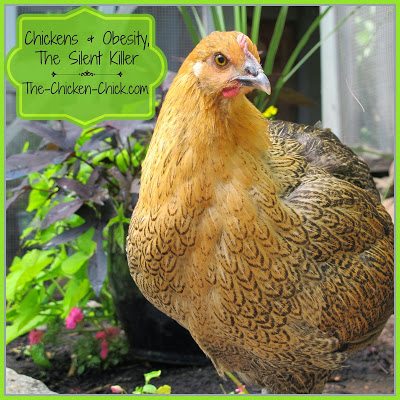
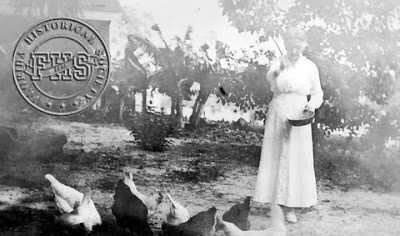


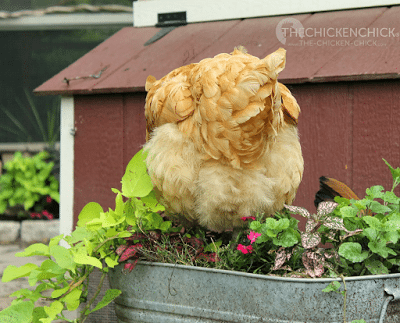
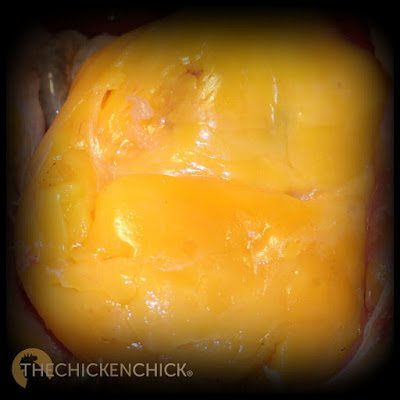
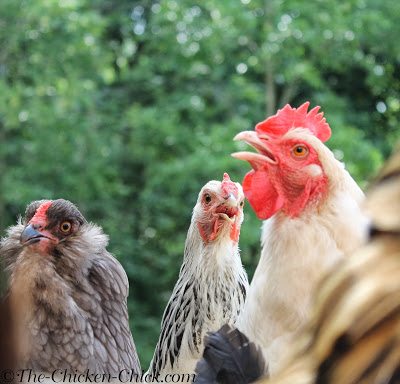
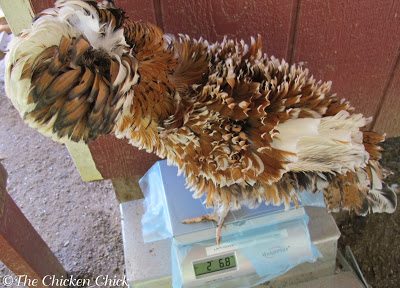
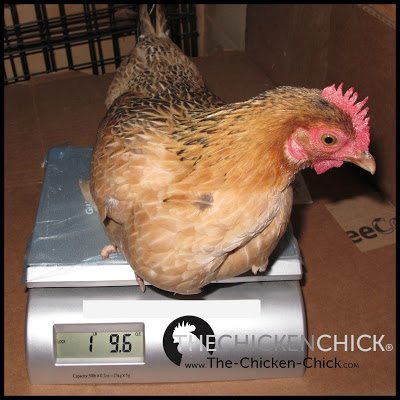
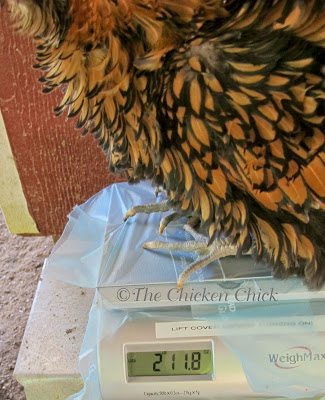
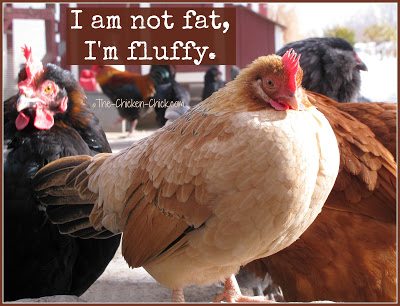



























thank you so much your amazing how you can own a farm and still have time to run this amazing website thx
Would love to win! I enjoy reading all the information provide by you and the chicken fountain crew.
I think I've entered already, but I don't know. You are a very generous chick and I can't keep straight which contests I've entered and which I've not. So, here's my entry, duplicate or not. Thanks ever so much for the opportunity.
Would love to try the fountain with my 50 girls!! Thanks for the chance to win one!
I really love your page and all the information you provide. My favorite is the continuing saga of Blaze and Rachael. Keep up the great work